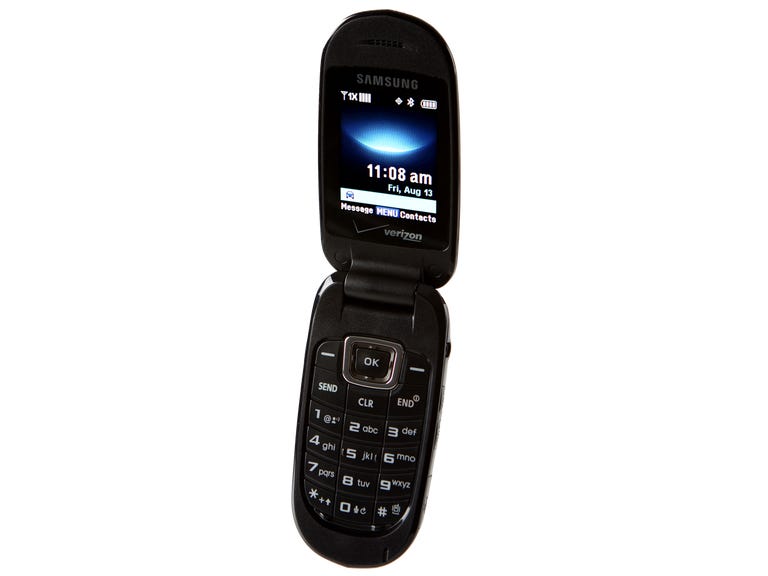As an entry-level metallic-gray-and-black flip phone, the Samsung Gusto is the spitting image of the Samsung Smooth, though its feature set and design slightly differ. Although there are some nice features inside, the phone's build and call quality are pretty unremarkable. The price, however, is very low--free from Verizon.com after an online discount and a new two-year contract, and $19.99 with a new contract after a $50 mail-in rebate, if you pick it up in retail stores.
The Good
The Bad
The Bottom Line
Design
Though one on hand the gray-and-black Samsung Gusto is a decently attractive flip phone, a closer look shows a glossy body so shiny and plasticky that it winds up looking cheap. Other design elements are limited to just a curve above the external screen, a slope on the back, and some nubbly texture.

The Gusto stands 3.8 inches tall, and measures 1.89 inches wide and 0.76 inch deep, so it will slip easily into a pocket or bag. Also, it weighs 3.28 ounces, which makes it light, but not a featherweight. On the front is the lens for the 1.3-megapixel camera and the 1.07-inch external color display that shows the date, time, and battery meter. On the right spine sits the Micro-USB charging port, a 2.5mm headset jack, and dedicated buttons to launch the camera and speakerphone. The left spine hosts the volume rocker. An external speaker is on the back.
Inside, there's a 2-inch display that supports 262,000 colors and a 128x160-pixel resolution. Though the resolution isn't as sharp as we've seen, we do appreciate the menu interface, which highlights menu options as you scroll up and down a vertical list. However, the scrolling is a little laggy. You can adjust backlight on the display and the alphanumeric keypad, along with display themes, and the contrast of the external LCD display. The font is not adjustable.
Below the Gusto's screen is the navigation array with two soft keys, a four-directional navigation pad and a central OK button, a Clear key, and the Talk and End/power controls. The keypad buttons are fairly large and slightly domed. Though the keys are separated, it's possible--but not the easiest--to dial by feel. The voice command shortcut shares space with the "0" button, which is less convenient than if it were to have a dedicated hardware control. The pound (#) button shares functionality with vibrate mode.
Features
Considering the Gusto's rock-bottom price point, we're not surprised to see minimal features onboard. The address book holds 1,000 contacts with room in each entry for five phone numbers, two e-mail addresses, two street addresses, a birthday, an instant messaging handle, and notes. You can also associate a contact with a photo or caller group, and with one of 20 ringtones, plus a beep mode and a silent mode.

The Gusto's organizer contains a calculator, a calendar, an alarm clock, a stop watch, a world clock, and a notepad. Text, picture, and voice messaging are joined by instant messaging, chat, and Internet access through a cramped and cluttered WAP browser. AT&T's Mobile E-mail gives you access to AOL and AIM mail, Gmail, Windows Live Hotmail, Yahoo, and other Web mail accounts, though e-mailing is awkward and time-consuming with the alphanumeric keypad. Also, keep in mind that the e-mail app costs $5 to download, plus whatever data usage exceeds your data plan. VZ Navigator with turn-by-turn directions costs $9.99 per month or $2.99 for a limited time period.
On the higher end, the Gusto offers stereo Bluetooth, voice commands (powered by Nuance), and a driving mode that reads out caller information. Yet, the handset's most intriguing feature is one that can get you out of an uncomfortable situation. You can set up the fake-call tool--located in the call settings--to flash a phone number or name of a fictional contact when you press the speakerphone buttons four times in succession. It's an interesting concept, no doubt, though we can't imagine using it more than a couple of times.
The Gusto's shooter is a bare-bones VGA camera that takes shots in three resolutions (640x480 pixels, 320x240 pixels, 160x120 pixels). There's also a night vision, a self timer, five white-balance settings, three quality settings, and four shutter sounds. Six color effects can jazz up the serviceable photos, some of which came out blurry, despite our efforts to hold the phone still. You can use photos as wallpaper, save them for caller ID, send them to a friend in a picture message, or upload them to an online Verizon album. The 32MB internal memory won't hold a ton of photos, however, and there's no external memory slot (not a black mark for a phone of this caliber), so we don't recommend getting overly camera-happy.

Although it's not the flashiest phone by a long shot, the Gusto lets you buy additional ringtones, apps, and games through the Verizon storefront. Ringtones typically start at $2.99 for a single tone, $5.49 for a two-fer, and $9.99 for a four-pack through the VZW Tones hub. Games typically range from $1.99 per month to $3.99 per month, or $6.99 to $8.99 for lifetime use.
Performance
We tested the dual-band (CDMA 850/1900; 1xRTT) Samsung Gusto in San Francisco using the Verizon Wireless network. Call quality was passable, though calls suffered from slightly weak volume and digitized voice quality. We also sometimes heard distortion. On their end, callers heard pervasive static, though the volume was fine.
The Gusto's speakerphone was tinny and distant on our end, not an unusual finding. Callers found it muddled on their side, though they mentioned it was not the worst speakerphone experience they encountered.
The Samsung Gusto has a rated battery life of 11 hours, with 20.8 days of standby time. The Gusto has a talk time of 7 hours and 2 minutes. FCC tests measure a digital SAR of 0.72 watt per kilogram.



